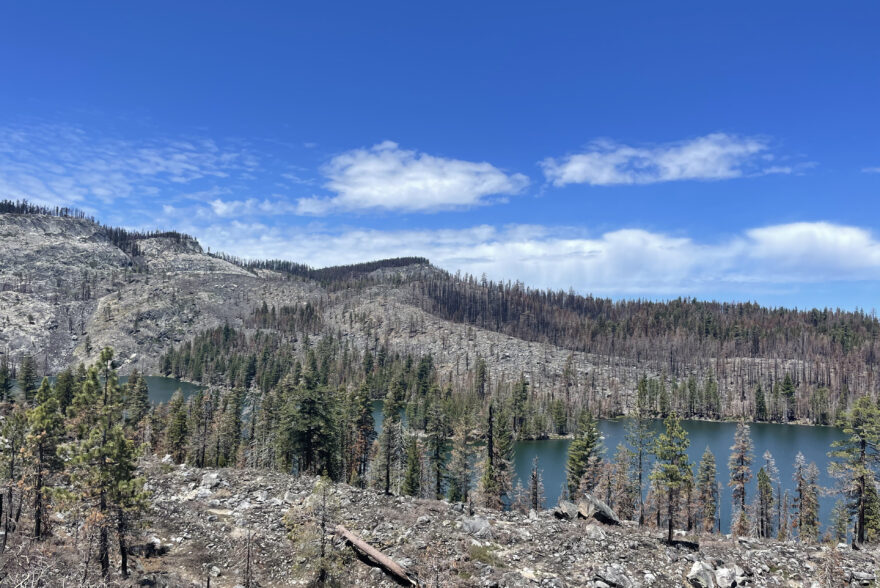Jan. 2024 Science Corner | Source Water Quality Impacts to Water Utilities


Many water supply headwaters in the western U.S. are at high risk for catastrophic fire due to a legacy of fire suppression, climate change, and land use changes. In collaboration with the World Resources Institute, Blue Forest has been building our capacity to estimate water quality benefits from our projects.
Written by: Sabrina Chui, Project Associate
Forest Resilience Bond projects, which are central to Blue Forest’s work and mission, depend on our ability to quantify and communicate the multiple benefits of watershed restoration to partners such as water utilities. Alongside water supply benefits, water quality protection is a critical concern for utilities, as catastrophic wildfires can introduce many types of dangerous pollutants into our water supply. Many water supply headwaters in the western U.S. are at high risk for catastrophic fire due to a legacy of fire suppression, climate change, and land use changes. In collaboration with the World Resources Institute, Blue Forest has been building our capacity to estimate water quality benefits from our projects.
Much of the water quality benefit from forest restoration arises from the costs avoided by changing fire behavior to reduce its impact as well as decreasing the likelihood of restored areas experiencing fires altogether. Water utilities, particularly those managing drinking water treatment plants (DWTPs), face significant challenges stemming from large and severe wildfires. These wildfires result in the depletion of vegetation, which is crucial for regulating hydrological processes and controlling erosion. In the aftermath of a severe fire, hydrophobic soils and reduced vegetation cover can lead to elevated sedimentation and an influx of pollutants such as organic carbon, nitrogen, and metals into waterways. The repercussions include decreased reservoir capacity, increased cleanup costs, accelerated infrastructure depreciation, and in severe cases, disruption of service. The increase in turbidity (a measure of water clarity) and concentration of pollutants at water intake locations increases costs immediately and in the long run.
The relationship between fire, erosion, sediment transport, and turbidity is complex and often dependent on the particular ecosystem or environment. To help estimate the water quality protection benefits of forest restoration projects to water utilities, Blue Forest integrates existing reports, post-fire turbidity data, and economic modeling. These resources help draw the crucial link between the biophysical impacts (increased turbidity) and economic results (increased costs to water utilities). For example, recent studies, including Price and Heberling’s comprehensive literature review, reveal the multifaceted costs incurred by water utilities due to increased turbidity and other pollutants.
These costs come from additional treatment processes necessary to meet potable water standards; additional testing and monitoring; temporary DWTP shutdowns during high turbidity events; water purchases from alternative sources during DWTP shutdowns; and more significant depreciation of infrastructure and subsequent replacement or upgrade costs. The study found that, on average, a 1% increase in turbidity will lead to a 0.14% increase in operations and maintenance (O&M) costs. On the biophysical side, recent data from the League to Save Lake Tahoe shows that turbidity levels reached 40 NTU, well over the standard of 3.0 NTU for the Lake Tahoe area, after the Caldor Fire. By applying the percent increases in cost found by Heberling, we can derive a high-level estimate of the O&M cost impacts on utilities.
Estimates like this can be refined by also including models, post-fire turbidity data, and cost analyses that are available for local areas. Blue Forest also looks at the difference in potential increases in O&M costs following a high and low-severity fire event. In some cases, after a high-severity fire, DWTPs may shut down when turbidity is over their treatment threshold for more than a few days. If that happens, even greater water purchase and conveyance costs replace water treatment. For any analysis, the aim is to showcase how forest restoration projects can lead to water supply reliability and substantial long-term savings for water utilities by mitigating the intensity of wildfires. While the reduced risk of costly fires may not be as tangible as direct revenue generation (for example, from increased water volume and hydropower generation), these water supply protection benefits represent a real value for water utilities in terms of risk mitigation.
As Blue Forest continues to engage with water utilities through the development of Forest Resilience Bond projects, we will continue to highlight the significant water quality protection that forest restoration provides from the adverse impacts of large, severe wildfires. We aim to partner with more water agencies as we refine our valuation of increased water treatment costs, DWTP shutdown costs, and infrastructure depreciation costs across more watersheds in California and the western U.S.